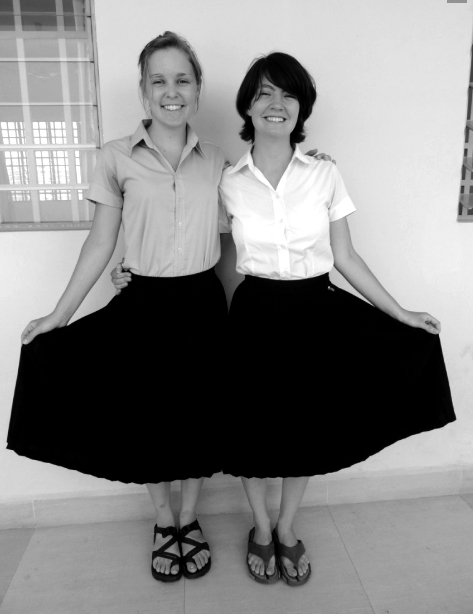I live in a wooden, stilted house with a family of four in a small seaside village of Cham Muslims, a Cambodian ethnic and religious minority. Less than a 20-minute bike ride away is the city of Kep, a tourist hot-spot that includes beaches, islands and crab.
An Estonian tourist asked me once in a chance encounter, “What is the most important thing you’ve learned in Khmer?” I approached that question in two ways: practically, with a Khmer word and its English counterpart; and then with sayings and their cultural meanings. However, on the inside I was not satisfied with my answer because I think that the Khmer language as a whole is the most important thing that I have learned on SST.One thing that I love about language is its richness. Words aren’t solely empty sounds created in our throats. They carry heavy emotions, deep meaning and light laughter. Instead of just describing situations, words mold our perceptions. In Khmer, I feel that the concept of “layng” has influenced my actions the most. By itself, “layng” means play. If it is tacked on after a verb, it means doing that action for fun. I have found that there is a lot of layng in daily service life.
Angkoy (sit) layng: Every afternoon my cousins set up a food stand in front of my house and sells prahut, small balls of fried ground meat that come in various shapes and colors. Every day I hear “sistuh, angkoy layng,” an invitation to sit for fun and pass the hours with the women that gather to sit and chat. As much as I’d also like to chat, for the most part all I can do is sit.
One day during “angkoy layng” I watched as people gathered around the ditch-pond where fish are farmed. The owners of the pond had drained it and they were now wading in the muck, catching large, slippery fish with their bare hands. “Jab trey (grab fish),” people told me with humor on their faces while making grabby hand gestures. We sat and watched patiently as they tossed bucketfuls of water out of the pond and watched with excited expectation as they secured a catch. Afternoons of angkoy layng have become my favorite.
Dae (walk) layng: In order to dae layng, the journey needs to be just as important as the possible, sometimes undetermined, destination. Since I live in a beautiful natural setting, I will either dae layng with my service partner, Maryn Munley, as we spot birds along the seaside or dae layng through the cow-filled rice paddies with my teenage family members.
Niyiey (speak) layng: Conversations where you niyiey layng always last longer than expected. I met a student at an Internet café who spoke English well. He also knew how to speak a tribal dialect as well as Khmer. His next task was to work on Korean and Chinese. With our knowledge of Khmer and English, it seemed as if there would never be an end to the things we could talk about.
Songsaa (sweetheart) layng-layng: Also the name of a popular Khmer song, when you have a songsaa layng-layng it means that your sweetheart loves someone else: an awful predicament with a rough kick of humor.
Even though I live in the same style house, eat the same food and go to the same places as my Cambodian community, I have only been able to truly experience life in Cambodia through the little Khmer that I have been able to understand. Learning through language has been the most enriching part of SST as I add a little more layng to how I walk, sit and speak.
Carina Zehr is a junior environmental science and sociology major. She is currently on Study-Service Term in Cambodia.


